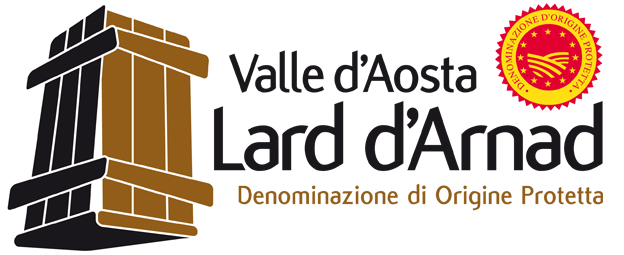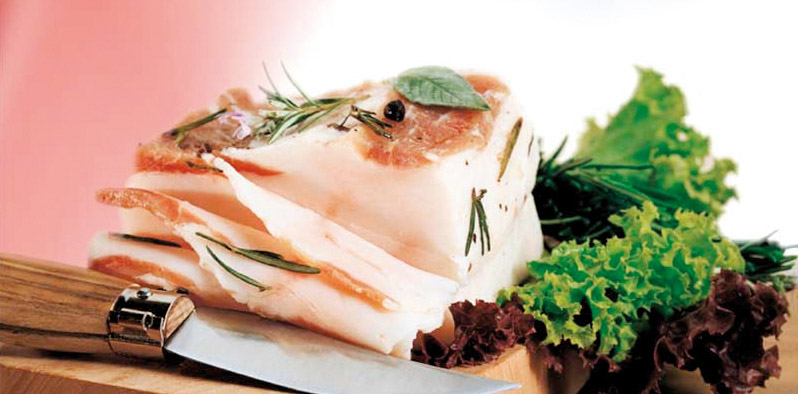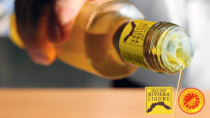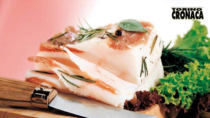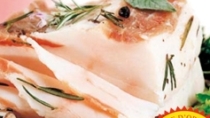Description
Valle d’Aosta Lard d’Arnad PDO is a charcuterie product produced with lard obtained from the shoulder and topside of pigs that are at least nine months old, belonging to the Large White, Italian Landrace and Duroc breeds, or other breeds compatible with the Italian heavy pig.
Production Area
The production area of Valle d’Aosta Lard d’Arnad PDO is within the territory of the municipal area of Arnad in the Province of Aosta, in the Valle d’Aosta region. The pigs used for processing must be born, reared and slaughtered within the regions of Valle d’Aosta, Piedmont, Lombardy, Veneto and Emilia-Romagna.
Production Method
Once cut, trimmed from the meat and cut into squares, the “baffe” (technical name for the rough pieces of fresh lard) are put into special chestnut, oak or larch wood containers (doils); this must take place within 48 hours of the day after slaughtering. During this time, the internal temperature of the baffe must be kept low to maintain the product’s characteristics. When the lard is put into the doils, each layer is alternated with a layer of salt and a layer of mixed aromatic herbs such as bay, sage, rosemary, clove, cinnamon, juniper, nutmeg, and pepper. The container is filled to the top and the product is covered with salted water; it is then boiled and left to cool in order to obtain the brine needed to preserve the product. The lard must rest in the doils for a minimum of three months.
Appearance and Flavour
Valle d’Aosta Lard d’Arnad PDO comes with the rind and is various shapes and sizes depending on the cut, with a minimum diameter of 3 cm (excluding the rind). The slice is white in colour, with rind on one side and the possible presence of a thin strip of lean meat; the centre is generally light pink without any veins. It has a compact consistency, yet is still soft. It has a pleasant flavour, reminiscent of the herbs used in the recipe.
History
The first historical documents referring to Valle d’Aosta Lard d’Arnad PDO date back to 1570. In an inventory made at the Castle of d’Arnad in 1763, “four doils of old lard” are listed. Doils, as the containers are referred to in the local patois dialect, have always been used to preserve and cure lard. This demonstrates that in past centuries there was a well-developed lard culture, which followed specific production and preservation methods still used by local producers today. In a later document, there is a description of a typical tavern in the city of Aosta, where all the dishes on the menu were laid out on a large table: among these there was "lard friand", which means “delectable lard”.
Gastronomy
Valle d’Aosta Lard d’Arnad PDO will keep for a long time if stored in a sealed container. Traditionally the product is eaten with pan dür (characteristic dark bread from Val d’Aosta) spread with honey, which enhances the lard’s sweet flavour. It has always been used as seasoning, but recently it has been “discovered” as a tasty starter, as well as an ingredient in typical local dishes. Curiously, Valle d’Aosta Lard d’Arnad PDO goes extremely well with boiled chestnuts, honey and Motzetta, another local charcuterie product, a combination that offers a sweet and savoury contrast, creating pleasant sensations on the palate.
Marketing
The product is marketed as Valle d’Aosta Lard d’Arnad PDO or Vallée d’Aoste Lard d’Arnad PDO. It is sold in pieces, unpackaged or vacuum-packed.
Distinctive Features
One of the distinctive features in the production of Valle d’Aosta Lard d’Arnad PDO is the pigs’ diet, which doesn’t contain integrated animal feed, so as to leave room for foods such as chestnuts and vegetables.



